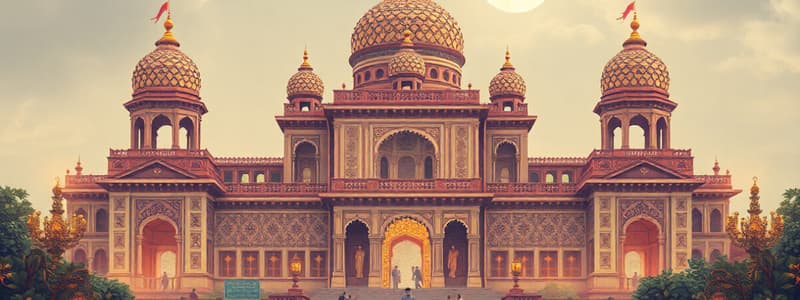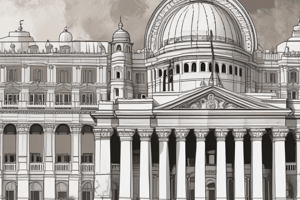Podcast
Questions and Answers
भारत में सरकार की संरचना किस प्रकार की है?
भारत में सरकार की संरचना किस प्रकार की है?
- एकात्मक गणराज्य
- राजशाही
- राष्ट्रपति शासन
- संघीय गणराज्य (correct)
भारत के संविधान में सरकार के तीनों अंगों के बीच शक्तियों के विभाजन को क्या कहा जाता है?
भारत के संविधान में सरकार के तीनों अंगों के बीच शक्तियों के विभाजन को क्या कहा जाता है?
- संघीयवाद
- सत्ता का पृथक्करण (correct)
- न्यायिक समीक्षा
- विधायी सर्वोच्चता
भारतीय संदर्भ में, लोकसभा क्या करती है?
भारतीय संदर्भ में, लोकसभा क्या करती है?
- न्यायाधीशों की नियुक्ति करती है
- राज्यपालों की नियुक्ति करती है
- कानून बनाने के लिए बिल पारित करती है (correct)
- राष्ट्रपति को चुनती है
भारत में राजनीतिक दल किस तरह से सरकार बनाते हैं?
भारत में राजनीतिक दल किस तरह से सरकार बनाते हैं?
भारत में आम चुनावों को कैसे संचालित किया जाता है?
भारत में आम चुनावों को कैसे संचालित किया जाता है?
केंद्र सरकार और राज्य सरकारों में क्या शक्ति साझा होती है?
केंद्र सरकार और राज्य सरकारों में क्या शक्ति साझा होती है?
भारत की राजनीतिक प्रणाली के सामने क्या चुनौतियां हैं?
भारत की राजनीतिक प्रणाली के सामने क्या चुनौतियां हैं?
भारत में राजनीतिक और सामाजिक परिदृश्य पर कौन-सी चुनौती सबसे बड़ी है?
भारत में राजनीतिक और सामाजिक परिदृश्य पर कौन-सी चुनौती सबसे बड़ी है?
भारतीय राजनीतिक प्रणाली में, राजनीतिक दलों के वित्तपोषण पर क्या चिंताएँ हैं?
भारतीय राजनीतिक प्रणाली में, राजनीतिक दलों के वित्तपोषण पर क्या चिंताएँ हैं?
भारतीय संविधान में नागरिकों को कौन-से मौलिक अधिकार प्रदान किए गए हैं?
भारतीय संविधान में नागरिकों को कौन-से मौलिक अधिकार प्रदान किए गए हैं?
भारतीय संविधान में मौलिक अधिकारों के उल्लंघन के मामलों को कौन सुनता है?
भारतीय संविधान में मौलिक अधिकारों के उल्लंघन के मामलों को कौन सुनता है?
भारत में नागरिकों के मौलिक कर्तव्यों का उल्लेख किसमें किया गया है?
भारत में नागरिकों के मौलिक कर्तव्यों का उल्लेख किसमें किया गया है?
संविधान में संशोधन कैसे किए जाते हैं?
संविधान में संशोधन कैसे किए जाते हैं?
भारत में न्यायिक समीक्ष का क्या अर्थ है?
भारत में न्यायिक समीक्ष का क्या अर्थ है?
भारतीय न्यायपालिका की स्वतंत्रता का क्या महत्व है?
भारतीय न्यायपालिका की स्वतंत्रता का क्या महत्व है?
भारत में नौकरशाही को बेहतर बनाने के लिए कौन-से कदम उठाए जा सकते हैं?
भारत में नौकरशाही को बेहतर बनाने के लिए कौन-से कदम उठाए जा सकते हैं?
भारतीय नौकरशाही की सबसे बड़ी चुनौती क्या है?
भारतीय नौकरशाही की सबसे बड़ी चुनौती क्या है?
भारतीय संविधान के अंतर्गत नागरिकों के मौलिक अधिकारों के उल्लंघन की स्थिति में, न्यायपालिका का क्या उत्तरदायित्व है?
भारतीय संविधान के अंतर्गत नागरिकों के मौलिक अधिकारों के उल्लंघन की स्थिति में, न्यायपालिका का क्या उत्तरदायित्व है?
Flashcards
भारत की राजनीतिक प्रणाली
भारत की राजनीतिक प्रणाली
भारत एक संघीय संसदीय गणराज्य है जिसमें विभिन्न शाखाएँ हैं।
संविधान के सिद्धांत
संविधान के सिद्धांत
भारतीय संविधान में शासन के लिए मूलभूत सिद्धांत होते हैं, जैसे शक्ति का पृथक्करण।
राष्ट्रपति
राष्ट्रपति
भारत का राष्ट्रपति राज्य का प्रमुख होता है, ज्यादातर सांकेतिक लेकिन कुछ शक्तियाँ भी रखता है।
प्रधानमंत्री
प्रधानमंत्री
Signup and view all the flashcards
द्व chambers संसद
द्व chambers संसद
Signup and view all the flashcards
चुनाव आयोग
चुनाव आयोग
Signup and view all the flashcards
मुख्य चुनौतियाँ
मुख्य चुनौतियाँ
Signup and view all the flashcards
सामाजिक विषमताएँ
सामाजिक विषमताएँ
Signup and view all the flashcards
संघीय सरकार की शक्तियाँ
संघीय सरकार की शक्तियाँ
Signup and view all the flashcards
मूल अधिकार
मूल अधिकार
Signup and view all the flashcards
संविधान के तहत कर्तव्य
संविधान के तहत कर्तव्य
Signup and view all the flashcards
संविधान संशोधन
संविधान संशोधन
Signup and view all the flashcards
ब्यूरोक्रेसी
ब्यूरोक्रेसी
Signup and view all the flashcards
प्रशासनिक दक्षता
प्रशासनिक दक्षता
Signup and view all the flashcards
न्यायपालिका
न्यायपालिका
Signup and view all the flashcards
मूल अधिकारों का उल्लंघन
मूल अधिकारों का उल्लंघन
Signup and view all the flashcards
न्यायिक समीक्षा
न्यायिक समीक्षा
Signup and view all the flashcards
सामान्य प्रशासन
सामान्य प्रशासन
Signup and view all the flashcards
Study Notes
Political System
- India is a federal parliamentary republic
- The Constitution of India outlines the fundamental principles of governance, including the separation of powers among the legislative, executive, and judicial branches.
- The President of India is the head of state, largely ceremonial but holds important powers in certain areas.
- The Prime Minister is the head of government and leader of the majority party in the Lok Sabha (lower house of parliament).
- Parliament is bicameral, consisting of the Lok Sabha (elected by the people) and the Rajya Sabha (representing states).
- The Indian judiciary is headed by the Supreme Court of India and includes a hierarchy of High Courts and lower courts. This system ensures judicial review and interpretation of laws.
Governmental Structure
- India's government structure is based on a federal system that divides power between the central government and state governments.
- Powers of the central government include: defense, foreign affairs, and currency.
- States have powers over areas like education, law and order, and agriculture.
- Constitutional provisions outline areas where both central and state governments hold concurrent authority.
- Various state legislative bodies exist alongside the central parliament, enacting their own laws for their specific area.
Political Parties and Elections
- Numerous political parties operate in India, ranging from national to regional parties.
- The system generally revolves around party-based coalitions to form a government.
- Elections to the Lok Sabha, and many state legislatures, are held at regular intervals.
- Voter turnout is usually high, but significant challenges still exist regarding accessibility and outreach for some segments of the population.
- The Election Commission of India is responsible for conducting free and fair elections.
- Candidates and parties often face scrutiny regarding funding and political financing practices.
Key Challenges
- Corruption remains a concern; preventing and addressing this is an ongoing challenge for the government.
- Poverty and inequality are pressing issues, impacting the political and social landscape.
- Social and economic disparities frequently influence political participation and outcomes.
- Security threats; including terrorism and communal violence, can affect policy and governance.
- Maintaining unity within a diverse country is a constant political concern.
Constitutional Provisions and Rights
- The Indian Constitution guarantees fundamental rights to its citizens, including freedom of speech, religion, and assembly.
- These rights are enshrined in the constitution and protect individuals against potential government overreach.
- The constitution also addresses fundamental duties of citizens.
- Provisions for amending the constitution are outlined and meticulously documented to ensure stability and prevent disruptions.
Bureaucracy
- A large and often complex bureaucracy exists at both central and state levels.
- Administrative efficiency and responsiveness to the needs of citizens is an ongoing challenge.
- The functioning of the bureaucracy is directly impacted and affected by the policies and governance systems put in place.
Role of Judiciary
- Independent judiciary plays a crucial role in ensuring the rule of law and upholding constitutional values.
- The judiciary hears cases involving violations of fundamental rights and arbitrates disputes between the central and state governments.
- Judicial review is a significant aspect of Indian governance.
Studying That Suits You
Use AI to generate personalized quizzes and flashcards to suit your learning preferences.





